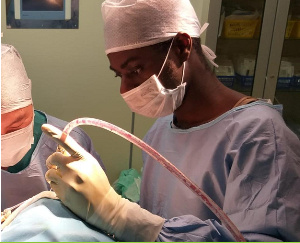- Home - News
- Polls
- Year In Review
- News Archive
- Crime & Punishment
- Politics
- Regional
- Editorial
- Health
- Ghanaians Abroad
- Tabloid
- Africa
- Religion
- Election 2020
- Coronavirus
- Photo Archives
- News Headlines
- Press Release
Health News of Sunday, 19 November 2023
Source: Simon Badu, Contributor
The intriguing world of dreams: A neurological perspective
For millennia, people have been captivated and interested by dreams. Myths, beliefs, and artistic expressions abound about these ethereal experiences that take place in our minds while we sleep.
But what's below these mysterious stories about the night? This essay delves into the intriguing field of dream neurology, examining how our brains plan these intricate and frequently bizarre mental excursions. We must first comprehend the architecture of our sleep cycles to comprehend the neurology of dreams. Rapid eye movement (REM) sleep and non-rapid eye movement (NREM) sleep are the two basic categories of sleep.
1. NREM Sleep: This is the first stage of sleep, which consists of multiple stages, each with its unique patterns of brain waves. Our bodies unwind and regenerative processes take place when we sleep in NREM. This phase is characterized by fewer dreams and, when they do occur, shorter, less vivid dreams.
2. REM Sleep: Dreams come true during the REM stage of sleep. To keep us from physically enacting our dreams, at this period our bodies are essentially paralyzed and our brains become extremely busy. Dreams that are the most vivid and memorable happen during the REM phase.
Even though we are still working to understand the intricacies of dreams, scientists have made great strides toward comprehending the brain processes underlying these mysterious experiences. The neurology of dreams involves multiple important brain regions and processes.
During REM sleep, the Prefrontal Cortex, an area linked to enhanced cognitive abilities, has a decrease in activity. The irrational and strange quality of many dreams may be explained by this decrease in prefrontal brain activity.
The Amygdala: The amygdala is in charge of processing emotions and becomes extremely active during REM sleep. The emotional intensity of dreams, which can range from pleasure and joy to fear and worry, may be explained by this activity.
The Hippocampus: This area is essential for the consolidation of memories. It seems that the hippocampus plays a role in incorporating aspects of our everyday lives into our dream narratives, which is why we sometimes recognize persons and places in our dreams.
The brainstem controls rapid eye movement (REM) sleep, which is linked to paralysis and atonia of the muscles. When it malfunctions, we are unable to physically act out our dreams, a condition known as REM sleep behavior disorder (RBD).
Researchers continue to disagree on the precise role and purpose of dreams. Many hypotheses have been put out to try and explain why humans dream:
1. Memory Consolidation: Dreams may aid in the processing and assembling of memories, enabling us to interpret our feelings and experiences.
2. Emotional Processing: According to some psychologists, dreams assist us in managing emotional difficulties and unsolved problems by processing and regulating our emotions.
3. Problem-Solving: As the brain examines several situations and connections, dreams may offer a forum for original problem-solving and insight development.
4. Random brain Activity: According to a different viewpoint, dreams have no particular purpose and are instead the product of random brain activity that occurs during REM sleep.
Research on the neuroscience of dreams is still ongoing and fascinating. Even though our knowledge of the brain mechanisms underlying dreaming has advanced significantly, the real reason and importance of these experiences are still being investigated and debated.
Dreams provide a glimpse into the complicated workings of the brain during its most mysterious hours, demonstrating the intricacy of the human mind. As our understanding of the neurological underpinnings of dreams expands, we may discover even more mysteries of this enigmatic world inside our minds.
Opinions










